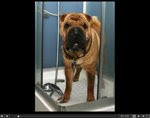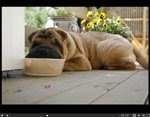The Shar Pei or Chinese Shar-Pei is a breed of dog known for its distinctive features of deep wrinkles and a blue-black tongue. The breed derives from China. The name (沙皮, pinyin: shā pí; English name probably derived from British spelling of Cantonese equivalent sā pèih) translates to "sand skin," and refers to the texture of its short, rough coat. As puppies, Shar Pei has numerous wrinkles, but sometimes as they mature, these wrinkles disappear as they "grow into their skin". Shar Pei were once named as one of the world's rarest dog breeds by the Guinness Book of World Records. The American Kennel Club did not recognize the breed until 1991.
The origin of the Chinese Shar-Pei can be traced to the province of Kwun Tung and has for centuries existed in the southern provinces of China. These dogs helped their peasant masters in various tasks such as herding cattle, guarding the home and family, and have proven themselves to be qualified hunters of "wild game, usually wild pigs."
The Shar-Pei is believed to have shared a common origin with the smooth-coated Chow-Chow because of the blue-black mouths and tongues, possibly the Great Pyrenees, a source of the double dewclaws, and the Tibetan Mastiff. It was believed in ancient times that the dark mouth of the Chow-Chow, exposed when barking, helped to ward off evil spirits. The Shar-Pei when translated means "sand-skin" or "shark skin." This uniquely rough, loose, prickly coat enabled the Shar-Pei to wriggle out of its opponents grasp while fighting in the dog pits.
(Incidentally, any dog in China that protects property is called a fighting dog, whereas in Canada and the United States they are referred to as guard dogs.)
The coat when stroked against the grain may be abrasive, producing a burning, itching sensation. Their tail is carried over their backs on either side exposing the anus. The first tail set is a tightly curled tail, a "coin" tail. The second tail set is the loose curl, and third is carried in an arch over the back. The Shar-Pei with his tail sticking out straight or between his legs was thought to be cowardly. The tail should denote bravery.
While viewing the body head on, if the toes were slightly turned out this was thought to help the dog with balance according to old-time dog-fighting fanciers. The Chinese crawling dragon with his feet pointed east and west was considered a sign of strength. Because of these poor breeding practices many of the Shar-Pei have bad fronts. A dog with straight forelegs is correct.
Following the establishment of the Peoples' Republic of China as a communist nation, the dog population was virtually wiped out. If not for the efforts of Matgo Law of Hong Kong, the Shar-Pei would not be here today. Due to his dedication to the breed, a small number of Shar-Pei was brought to the United States in the 1960s and early '70s. In 1974 American and Canadian fanciers answered Matgo's appeal for help and in 1976 the first Shar-Pei was registered. The foundation stock brought over from Hong Kong were of poorer quality than the Shar-Pei we see today. In August of 1991 the Shar-Pei officially completed the requirements for recognition by the American Kennel club and was placed in the Non-Sporting Group. In 1992 the Canadian Kennel Club also officially recognized and grouped the Shar-Pei in group 6, Non-Sporting n g events. Since that time several Shar-Pei are now and continuing to become CKC and AKC champions.
Shar Pei comes in many different colors such as fawn, red (rose), sand, cream, black, lilac and blue. They resemble the Chow Chow due to having the same blue-black tongue. There are over sixteen recognized colors in AKC. The coat must be solid in color and any Shar-Pei with a "flowered coat" (spotted) or black and tan in coloration (i.e. German Shepherd) is a disqualification. Colors include black, cream, fawn, red-fawn, red, sable, apricot, chocolate, isabella, and blue. The nose may be black or brick (pink with black), with or without a black mask. A Shar-Pei can also have what is called a "dilute" coloration. Meaning the nose, nails and anus of the dog is the same color as the coat, (i.e. chocolate coat with chocolate nose, nails and anus). All of these color variations are acceptable and beautiful, but the coat color must be solid and well blended throughout the whole body of the dog.
Shar Pei comes in three different coat types; horse, brush and bear coat. The unusual horse-coat is rough to the touch, extremely prickly and off-standing and is closer to the original Shar Pei breed in appearance and coat type than the Brush or Bear Coat. This coat is fairly prickly, and can be rough or irritating when petting in the opposite direction of the fur. The Horse Coat is generally thought to be more active and predisposed to dominant behavior than the Brush Coat. The brush-coated variety has slightly longer hair and a smoother feel to them. The Brush Coat is generally considered to be more of a 'couch potato' than the Horse Coat.
The Chinese Shar-Pei is a unique and intelligent dog most often recognized for its wrinkles. Initially developed as an all - purpose Chinese farm dog, the breed does well today in obedience, agility, herding and tracking, with skills that would have been needed on the farm. Because the name "Shar-Pei" means "sand coat", harshness is a distinctive feature in its two accepted coat types, either horse (short) or brush (up to an inch long). Other unique qualities include black mouth pigment, a slightly "hippo-like" head shape, small ears, deepset eyes and rising topline.
All Shar-Pei, but especially the horse coat needs early socialization with children, strangers, and other animals. They can be stubborn, strong willed and very territorial. Early training can help control these traits before they become problem behaviors. Some people may experience sensitivity to the harshness of the coat of either length. This is a mild, short-lived rash, that can develop on the skin that has been in contact with the coat, most commonly on the forearms.
The brushcoat matures early to be a stocky strong dog, therefore early socialization and training are essential, in order to have a dog that is a good family member as well as a welcome member of society. The brushcoat is not always as active as the horsecoat, and are often more content than the horsecoat to laze around the house. Like their horsecoat brothers, they are strong willed, stubborn and territorial, but these are often exhibited to a lesser degree. Both coat types, brush and horse are true Shar- Pei.
WrinklesShar Pei usually comes in two varieties: one is covered in large folds of wrinkles, even into adulthood (the Western type). The other variation has skin that appears tighter on its body, with wrinkles just on the face and at the withers (the original type).
TemperamentThe Shar Pei is often suspicious of strangers, which pertains to their origin as a guard dog. In general the breed has proved itself to be a loving, devoted family dog. The Shar Pei is also very independent and reserved breeds. Nevertheless, the Shar Pei is extremely devoted, loyal and affectionate to its family, and is amenable to accepting strangers given time and proper introduction at a young age. If poorly socialized or trained, it can become especially territorial and aggressive. Even friendly and well-socialized individuals will retain the breed's watchdog proclivities (such as barking at strangers). It is a largely silent breed, barking only when playing or when worried. The Shar Pei was originally bred as palace guards in China. While this breed is adorable it is also very protective of its home and family, a powerful dog that is willing to guard its family members.
The breed is amenable to training, but can get bored from repetition. Overall, the Shar Pei is a dog that is loyal and loving to its family while being very protective and independent.
Source:
Internet
 I love to be out playing in the snow. So when the first snow of this year fell on October 29, I did not need to be asked twice to go out to play. I Post some picture so you can see, my first impressions in the snow for this year. Since I have become so fond of using the slideshow, I post some pictures of this just under slideshow.
I love to be out playing in the snow. So when the first snow of this year fell on October 29, I did not need to be asked twice to go out to play. I Post some picture so you can see, my first impressions in the snow for this year. Since I have become so fond of using the slideshow, I post some pictures of this just under slideshow.










 I like to go hicking. Sometimes I meet on other animals such as horses, dogs, pigs and others animals. Sometimes I meet the animals on a farm, but often I meet them on my many trips. I like virtually all animals. But not cats, for they tend to tease me, and I do not like it. I attach some pictures where I meet other animals, so you can see for yourself. Hope you like them.
I like to go hicking. Sometimes I meet on other animals such as horses, dogs, pigs and others animals. Sometimes I meet the animals on a farm, but often I meet them on my many trips. I like virtually all animals. But not cats, for they tend to tease me, and I do not like it. I attach some pictures where I meet other animals, so you can see for yourself. Hope you like them.






